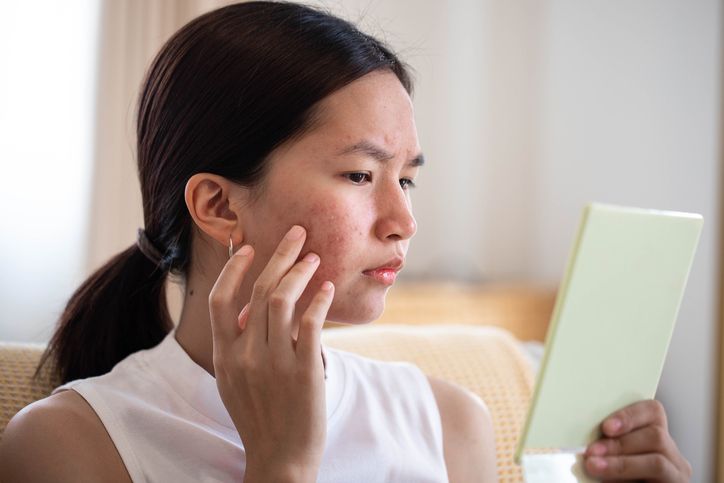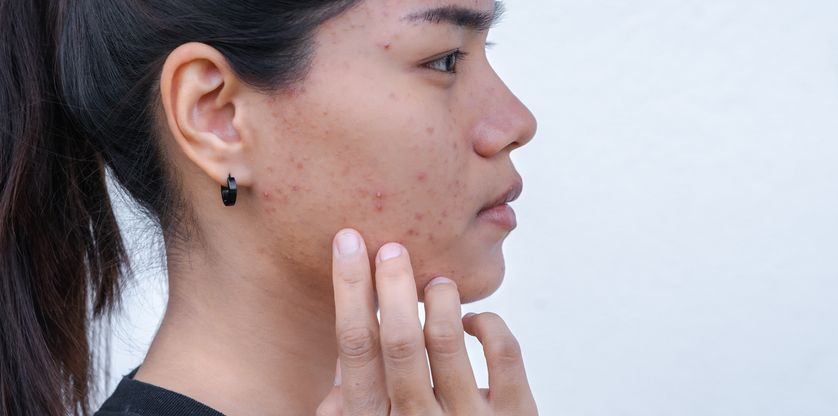- Home
- Trend
- Weight Loss Strategies
- Acne Tips
- Hair Health Information
- Blemish Removal Tips
- Acne Scar Removal Tips
- Muscle Building Techniques
- Intimate Care Tips
- Postpartum Intimate Care
- Eye Bags Wiki
- Tips for Face Slimming
- Secret of Permanent Hair Removal
- Breast Enlargement Tips
- Cure to Snoring
- Marionette Lines
- Skin-Tightening Secrets
Many people—especially teenagers going through puberty—have experienced facial acne at some point. It’s a frustrating condition that’s often tough to fully resolve and prone to recurring. To eliminate acne at the root, it’s essential to first understand what causes it. Only then can we find the right solution and reduce the chances of it coming back. Interestingly, according to Traditional Chinese Medicine (TCM), the location of your acne can reveal different internal health problems. In this article, we’ll uncover the main causes of acne and teach you how to effectively fight back.
Main Causes of Acne

Cause #1: Excessive Sebum Production
Our skin is covered in tiny glands called sebaceous glands, which produce sebum to moisturize and protect our skin from dryness. However, when these glands become overactive and produce too much oil, the excess sebum can mix with dirt and other impurities, clogging pores. This creates an ideal environment for acne-causing bacteria to grow, leading to breakouts.
Cause #2: Thickened Stratum Corneum (Dead Skin Layer)
An overly thick stratum corneum—the outermost layer of the skin—is another major acne culprit. Normally, this layer renews itself every 28 days, with old skin cells naturally shedding as new ones rise to the surface. However, when metabolism slows due to various factors, old skin cells may not shed properly, leading to buildup. This accumulation can clog hair follicles, causing blackheads and whiteheads, which may eventually become inflamed and turn into acne.
Cause #3: Hormonal Imbalance
You’ve probably noticed that teens tend to get acne more easily. That’s because puberty causes major shifts in hormone levels—particularly a surge in androgens (male hormones), which stimulate oil production and increase acne risk. Even females produce androgens, and fluctuations during puberty can also lead to acne. Hormonal imbalances triggered by stress, menstruation, or pregnancy can also raise the likelihood of breakouts.
Cause #4: Unhealthy Eating Habits (TCM Perspective)
From a TCM standpoint, diet plays a key role in acne development. Frequently eating greasy, fried, or spicy foods can upset the stomach and impair digestive functions, leading to damp-heat accumulation in the spleen and stomach, which manifests as acne. Additionally, high-sugar foods can spike blood sugar and insulin levels, further boosting oil production and triggering breakouts.
Cause #5: Staying Up Late
Late nights don’t just harm overall health—they can also wreak havoc on your skin. The body's detox and metabolic processes are most active between 11 PM and 2 AM. If you’re not in deep sleep during this time, your body’s ability to eliminate toxins is disrupted, and these toxins may show up on your skin as acne. Sleep deprivation can also throw your hormones out of balance, increasing acne risk.
TCM vs. Western Medicine: Different Views on Acne

Western medicine typically sees acne as a result of factors like excess oil, thickened skin, hormonal imbalance, and bacterial infection. TCM, on the other hand, views acne as a manifestation of internal imbalances—particularly heat and dampness trapped within the body's meridians and organs. These internal toxins disrupt your health and surface as acne.
For instance, meridians associated with the lungs and stomach pass through the face and chest. If too much heat or dampness accumulates, it follows these pathways and causes breakouts in those areas. Similarly, if pathogenic wind invades the lungs, it can increase lung heat and trigger acne. Greasy or spicy food can disrupt the spleen and stomach, causing internal heat that also leads to breakouts.
TCM also believes that emotional health plays a role. Chronic stress, anxiety, anger, or depression can disrupt the body's yin-yang balance, increasing heat and dampness and ultimately resulting in acne.
免費體驗
Acne Treatment
1 Minute Self-Registration
Date should not be before minimal date
What Your Acne Location Reveals About Your Health (TCM Insight)
According to the Huangdi Neijing, “Internal problems manifest externally.” That means when your body has hidden health issues, they often show up on your skin. Here's what different acne spots may indicate:
i. Forehead Acne
In TCM, the forehead corresponds to the heart and liver. Acne here may signal excess heart or liver fire. Stress, anxiety, and emotional suppression can lead to liver qi stagnation and heat buildup, surfacing as forehead acne. Sleep deprivation also hinders the liver's detoxification between 11 PM and 2 AM, leading to forehead breakouts. Recommended: manage stress, avoid late nights, and maintain good sleep hygiene.
ii. Left Cheek Acne
The left cheek is linked to liver health. Poor blood circulation and impaired liver detox can lead to breakouts here. Recommended: regular exercise to boost circulation and mood.
iii. Right Cheek Acne
The right cheek relates to lung function. Lung heat, dry throat, coughing, and phlegm may contribute to breakouts. Recommended: avoid BBQ, hotpot, and fried foods; eat lung-nourishing foods like lily bulbs, white fungus, and pears.
iv. Nose Acne
The nose reflects the spleen and stomach. Digestive issues like stomach heat, constipation, or bloating can trigger breakouts on the bridge or tip of the nose. Peeling on the nose tip may also indicate poor circulation and lung heat. Recommended: eat lightly, avoid greasy and spicy foods, and maintain regular meals.
v. Lip and Philtrum Acne
These areas correspond to the intestines. Acne here may point to intestinal heat or constipation—often caused by low veggie intake and high meat or processed food consumption. Recommended: eat more fruits and vegetables to support digestion and detox.
vi. Chin Acne
Chin breakouts are typically linked to hormonal imbalances, especially in women before their period due to a rise in progesterone. This stimulates oil production and increases acne risk. Recommended: avoid cold foods and drinks before and during menstruation.
What Are the Methods for Treating Acne?
i. Applying Acne Cream
Most people apply acne cream directly to breakouts to treat the condition. There are many different brands of acne creams on the market, each with varying ingredients and formulations, leading to differences in effectiveness. Common ingredients include benzoyl peroxide, sulfur, alpha hydroxy acids, and aloe vera. These components help control sebum production, kill acne-causing bacteria, and reduce skin inflammation to help clear acne.
However, since acne creams are topical treatments applied only to the skin’s surface, the active ingredients may not penetrate deeply enough to be effective. Frequent use can also lead to excessive dryness, itching, and peeling of the skin.
ii. Using Tea Tree Oil
Tea tree oil is an essential oil extracted from the tea tree plant. It’s known to kill acne-causing bacteria and soothe inflammation, making it a popular choice for treating breakouts. However, high concentrations of tea tree oil can cause skin burns and worsen acne, increasing the likelihood of scarring and hyperpigmentation.
It’s recommended to dilute tea tree oil at a ratio of 1:99 with water before use. Apply the mixture with a cotton swab directly onto the affected area. Once the skin absorbs it, follow up with a lightweight moisturizer to replenish hydration and lock in moisture.
iii. Using Acid-Based Products
In recent years, many have turned to acid-based products—such as salicylic acid, retinoic acid, and mandelic acid—to treat acne. These ingredients help dissolve excess oil, blackheads, and comedones in the pores and reduce inflammation. However, they can also irritate the skin. Applying these acids to inflamed acne may worsen the condition, so frequent use is not advised.
Those with severe acne, sensitive skin, or open wounds should avoid using acid-based products for acne treatment.
iv. Dietary Therapy
Dietary changes can also help with acne. For example, bitter melon can clear heat and detoxify the body, which may help reduce acne caused by excess internal heat. Green tea contains polyphenols and antioxidants that soothe inflammation and promote skin cell renewal, aiding in acne recovery. Additionally, foods like aloe vera, honey, and deep-sea fish are rich in nutrients that support skin health and help combat acne.
Perfect Medical Acne Treatment – More Effective, Faster, and Safer Acne Care!
Dealing with cheek acne can be frustrating. While over-the-counter creams and treatments can help, they often take time to show noticeable results. Because acne requires urgent care, Perfect Medical has introduced the Acne Treatment to help sufferers combat breakouts more effectively, efficiently, and safely.
This treatment uses vacuum microdermabrasion technology to quickly and painlessly remove surface oil, dead skin cells, blackheads, and whiteheads, helping to unclog pores. This reduces inflammation and effectively prevents future breakouts.
Additionally, the treatment infuses the skin with medical-grade skincare serums to deeply hydrate and balance oil production, helping to maintain a healthy skin barrier and prevent future acne. It also stimulates collagen regeneration, which fades acne scars and pitted marks while improving overall skin texture.
Special Offer: Interested in trying the treatment? Perfect Medical offers a free first-time trial. Just click the link below to book your session!
Free Trial: Perfect Medical Acne Treatment免費體驗
Acne Treatment
1 Minute Self-Registration
Date should not be before minimal date
FAQ

What are the causes of acne?
Acne can be caused by a variety of factors, but it usually stems from excessive sebum production leading to clogged pores. Thickened stratum corneum (outer skin layer), hormonal imbalances, poor diet, and lack of sleep are also common culprits.
What do cheek acne locations indicate about your health?
According to Traditional Chinese Medicine, the location of acne on your face can reveal underlying internal health issues. Acne on the forehead is often associated with excess heat in the heart or liver. If it appears on the left cheek, it may be linked to liver problems, while acne on the right cheek is typically connected to lung issues. Breakouts on the nose can suggest an imbalance in the digestive system, particularly the spleen or stomach. Pimples above the lips or around the philtrum are thought to indicate intestinal problems. Lastly, acne on the chin is commonly seen as a sign of hormonal imbalance.
What are some ways to get rid of acne?
Common methods include using acne cream or pimple patches. Other remedies include tea tree oil, acid-based products, aloe vera masks, and improving diet and lifestyle habits.
Can the Perfect Medical Acne Treatment remove blackheads and whiteheads?
Yes, the treatment not only targets acne but also effectively removes blackheads and whiteheads, helping to restore clear and unclogged pores.
Will the Acne Treatment damage the skin?
Not at all. It’s a non-invasive, pain-free treatment that does not harm or irritate the skin. The procedure is gentle and comfortable throughout.









